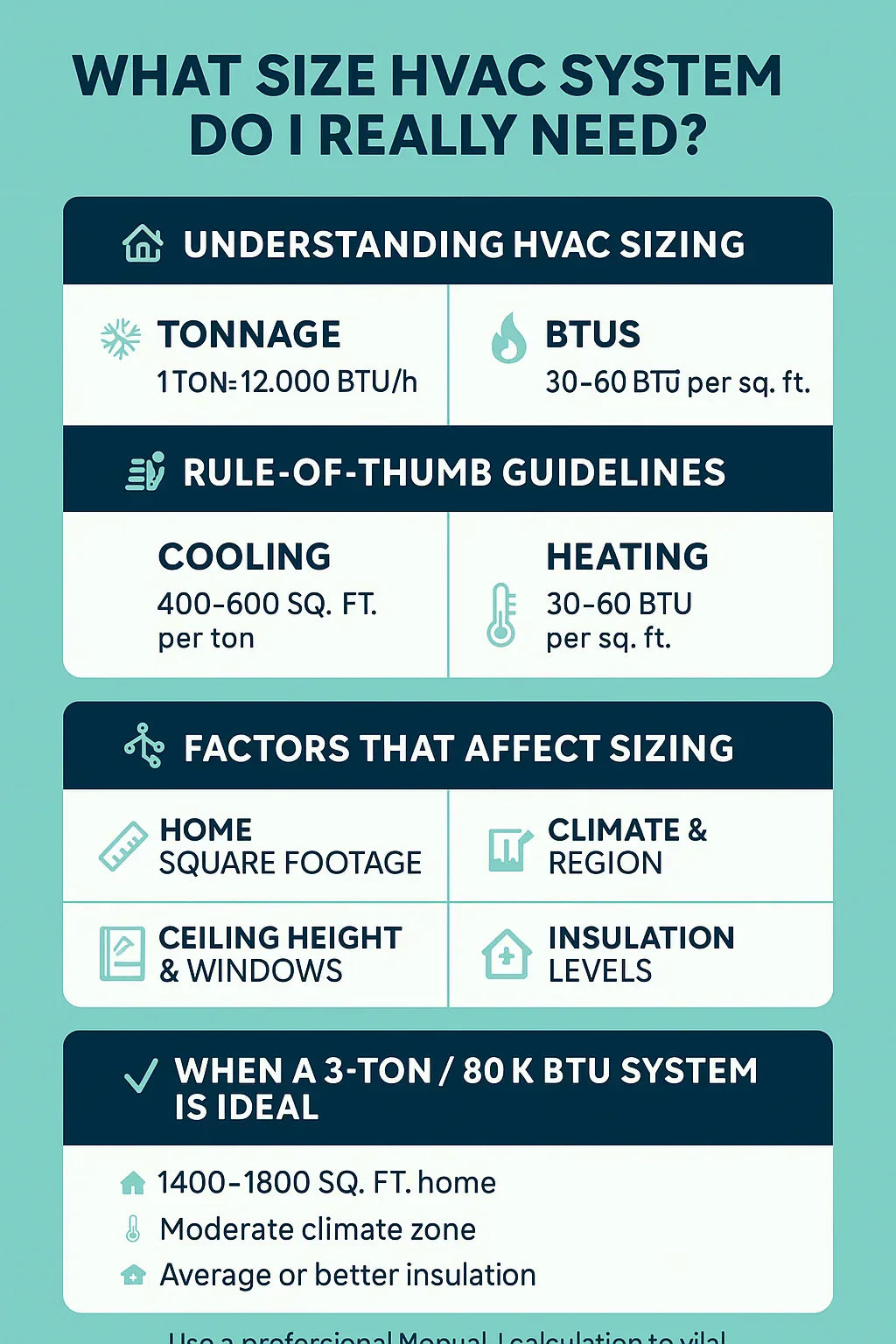📏 1. What “Tonnage” and BTUs Actually Mean
-
Tonnage in HVAC refers to cooling capacity: 1 ton = 12,000 BTUs/hour of cooling.
-
BTUs (British Thermal Units) measure heating power.
-
An 80,000 BTU furnace can heat about 1,500–2,000 sq ft depending on climate and insulation.
-
Understanding these terms helps you match the right system (like a 3-ton AC with 80,000 BTU furnace) to your home’s needs.
🧠 2. Square Footage Rules of Thumb (Starting Point Only)
Cooling:
| Home Size (sq ft) | AC Size (tons) |
|---|---|
| 1,200–1,500 | 2.5 |
| 1,500–1,800 | 3.0 |
| 1,800–2,200 | 3.5 |
| 2,200–2,500 | 4.0 |
Heating:
| Home Size (sq ft) | Furnace BTUs Needed (approx.) |
| 1,200–1,500 | 50,000–70,000 |
| 1,500–2,000 | 70,000–90,000 |
| 2,000–2,500 | 90,000–110,000 |
Note: These ranges are broad. Manual J is always better.
🏡 3. What Affects HVAC Sizing Beyond Square Footage?
🔥 Climate Zone
-
Hotter climates (Texas, Florida): may need more cooling tonnage.
-
Colder climates (Minnesota, Maine): prioritize furnace BTUs.
🧱 Insulation & Building Envelope
-
Poorly insulated homes lose more heat/cool air.
-
Single-pane windows, air leaks, and unsealed ductwork all increase demand.
📐 Ceiling Height
-
9–10 foot ceilings = more volume to condition → consider upsizing.
🌞 Window Placement
-
South/west-facing windows raise cooling load.
🧍♂️ Occupants & Appliances
-
More people = more body heat
-
Kitchens with ovens, media rooms with electronics add load
📋 4. Manual J Load Calculation: The Gold Standard
A Manual J assessment considers:
-
Room dimensions
-
Orientation to sun
-
Insulation values (R-values)
-
Air leakage
-
Duct layout and condition
-
Appliance heat gain
-
Occupancy
Ask your HVAC contractor for one before purchasing a new system. Many online tools approximate Manual J results.
Try: HVAC Load Calculator by HVAC-Direct
⚖️ 5. Why Oversizing Is a Problem
AC:
-
Short cycling = turns on/off rapidly, reduces lifespan
-
Poor dehumidification = sticky air, mold risk
Furnace:
-
Rapid bursts of heat, then off = uneven temps
-
Can overheat and shut off prematurely
Results:
-
Higher energy bills
-
Noise from startup cycles
-
Greater wear and tear on parts
🎯 6. When a 3-Ton AC + 80,000 BTU Furnace Is the Right Fit
-
Home size: 1,500–2,000 sq ft
-
Climate: moderate or mixed (e.g. midwestern states)
-
Decent insulation and newer windows
-
Standard ceiling heights
-
Typical family size (3–5 occupants)
If you're in Texas or Florida? You may need a 3.5–4 ton AC instead. If you’re in Minnesota with poor insulation? A 90,000–100,000 BTU furnace might be better.
🔧 7. Upgrade Tips When Sizing for Replacement
-
Check your current system’s size on the nameplate
-
Ask: Did it struggle to keep up?
-
Evaluate your comfort history: hot/cold rooms?
-
Consider upgrading ducts if airflow was weak
-
Pair your system with a properly matched coil (TXV preferred for efficiency)
📲 8. Handy Sizing Tools and Resources
🧭 Final Takeaway
"Getting HVAC sizing right isn’t just about square footage — it’s about comfort, efficiency, and long-term value."
For many mid-size homes, a 3-ton AC and 80,000 BTU furnace like Goodman’s combo system is ideal — but only if it’s matched to your home’s true load needs.
Invest time in proper sizing now to avoid years of high bills, hot rooms, and expensive fixes later.
In the next topic we will know more about: How SEER2 and AFUE Ratings Really Impact Your Energy Bill (and What to Look For)







